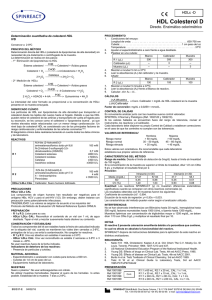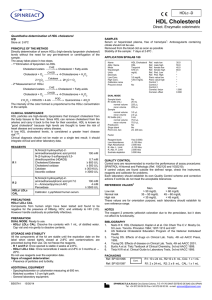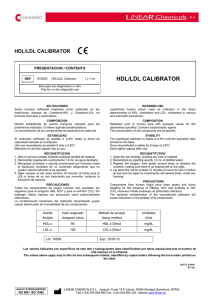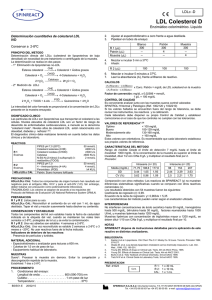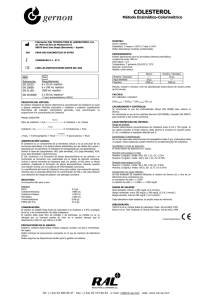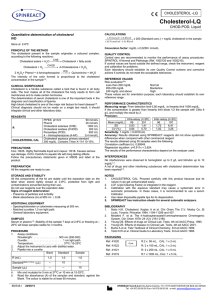Determinación cuantitativa de glucosa
Anuncio
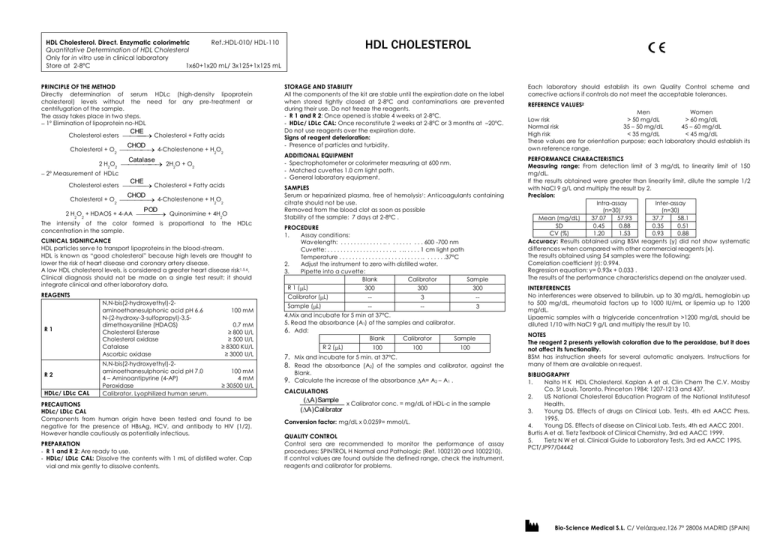
HDL CHOLESTEROL HDL Cholesterol. Direct. Enzymatic colorimetric Ref.:HDL-010/ HDL-110 Quantitative Determination of HDL Cholesterol Only for in vitro use in clinical laboratory Store at 2-8ºC 1x60+1x20 mL/ 3x125+1x125 mL PRINCIPLE OF THE METHOD Directly determination of serum HDLc (high-density lipoprotein cholesterol) levels without the need for any pre-treatment or centrifugation of the sample. The assay takes place in two steps. 1º Elimination of lipoprotein no-HDL Cholesterol esters CHE Cholesterol + Fatty acids Cholesterol + O2 CHOD 4-Cholestenone + H2O2 2 H2O2 Catalase ADDITIONAL EQUIPMENT - Spectrophotometer or colorimeter measuring at 600 nm. - Matched cuvettes 1.0 cm light path. - General laboratory equipment. 2H2O + O2 2º Measurement of HDLc Cholesterol esters CHE Cholesterol + Fatty acids Cholesterol + O2 CHOD 4-Cholestenone + H2O2 2 H2O2 + HDAOS + 4-AA POD Quinonimine + 4H2O The intensity of the color formed is proportional to the concentration in the sample. HDLc CLINICAL SIGNIFICANCE HDL particles serve to transport lipoproteins in the blood-stream. HDL is known as “good cholesterol” because high levels are thought to lower the risk of heart disease and coronary artery disease. A low HDL cholesterol levels, is considered a greater heart disease risk1,5,6. Clinical diagnosis should not be made on a single test result; it should integrate clinical and other laboratory data. REAGENTS R1 R2 HDLc/ LDLc CAL N,N-bis(2-hydroxyethyl)-2aminoethanesulphonic acid pH 6.6 N-(2-hydroxy-3-sulfopropyl)-3,5dimethoxyaniline (HDAOS) Cholesterol Esterase Cholesterol oxidase Catalase Ascorbic oxidase N,N-bis(2-hydroxyethyl)-2aminoethanesulphonic acid pH 7.0 4 – Aminoantipyrine (4-AP) Peroxidase Calibrator. Lyophilized human serum. STORAGE AND STABILITY All the components of the kit are stable until the expiration date on the label when stored tightly closed at 2-8ºC and contaminations are prevented during their use. Do not freeze the reagents. - R 1 and R 2: Once opened is stable 4 weeks at 2-8ºC. - HDLc/ LDLc CAL: Once reconstitute 2 weeks at 2-8ºC or 3 months at –20ºC. Do not use reagents over the expiration date. Signs of reagent deterioration: - Presence of particles and turbidity. 100 mM 0.7 mM ≥ 800 U/L ≥ 500 U/L ≥ 8300 KU/L ≥ 3000 U/L 100 mM 4 mM ≥ 30500 U/L PRECAUTIONS HDLc/ LDLc CAL Components from human origin have been tested and found to be negative for the presence of HBsAg, HCV, and antibody to HIV (1/2). However handle cautiously as potentially infectious. PREPARATION - R 1 and R 2: Are ready to use. - HDLc/ LDLc CAL: Dissolve the contents with 1 mL of distilled water. Cap vial and mix gently to dissolve contents. SAMPLES Serum or heparinized plasma, free of hemolysis1: Anticoagulants containing citrate should not be use. Removed from the blood clot as soon as possible Stability of the sample: 7 days at 2-8ºC . PROCEDURE 1. Assay conditions: Wavelength: . . . . . . . . . . . . . .. . . . . . . . . . . 600 -700 nm Cuvette: . . . . . . . . . . . . . . . . . . . . .. . .. . . . . 1 cm light path Temperature . . . . . . . . . . . . . . . . . . . . . . . . . .. . . . . . .37ºC 2. Adjust the instrument to zero with distilled water. 3. Pipette into a cuvette: Blank Calibrator Sample R 1 ( L) 300 300 300 Calibrator ( L) -3 -Sample ( L) -- -- 3 4.Mix and incubate for 5 min at 37ºC. 5. Read the absorbance (A1) of the samples and calibrator. 6. Add: Blank Calibrator Sample R 2 ( L) 100 100 100 7. Mix and incubate for 5 min. at 37ºC. 8. Read the absorbance (A2) of the samples and calibrator, against the Blank. 9. Calculate the increase of the absorbance A= A2 – A1 . CALCULATIONS ( A ) Sample x Calibrator conc. = mg/dL of HDL-c in the sample ( A ) Calibrator Conversion factor: mg/dL x 0.0259= mmol/L. QUALITY CONTROL Control sera are recommended to monitor the performance of assay procedures: SPINTROL H Normal and Pathologic (Ref. 1002120 and 1002210). If control values are found outside the defined range, check the instrument, reagents and calibrator for problems. Each laboratory should establish its own Quality Control scheme and corrective actions if controls do not meet the acceptable tolerances. REFERENCE VALUES2 Men Women Low risk > 50 mg/dL > 60 mg/dL Normal risk 35 – 50 mg/dL 45 – 60 mg/dL High risk < 35 mg/dL < 45 mg/dL These values are for orientation purpose; each laboratory should establish its own reference range. PERFORMANCE CHARACTERISTICS Measuring range: From detection limit of 3 mg/dL to linearity limit of 150 mg/dL. If the results obtained were greater than linearity limit, dilute the sample 1/2 with NaCl 9 g/L and multiply the result by 2. Precision: Intra-assay Inter-assay (n=30) (n=30) Mean (mg/dL) 37.07 57.93 37.7 58.1 SD 0.45 0.88 0.35 0.51 CV (%) 1.20 1.53 0.93 0.88 Accuracy: Results obtained using BSM reagents (y) did not show systematic differences when compared with other commercial reagents (x). The results obtained using 54 samples were the following: Correlation coefficient (r): 0.994. Regression equation: y= 0.93x + 0.033 . The results of the performance characteristics depend on the analyzer used. INTERFERENCES No interferences were observed to bilirubin. up to 30 mg/dL, hemoglobin up to 500 mg/dL, rheumatoid factors up to 1000 IU/mL or lipemia up to 1200 mg/dL. Lipaemic samples with a triglyceride concentration >1200 mg/dL should be diluted 1/10 with NaCl 9 g/L and multiply the result by 10. NOTES The reagent 2 presents yellowish coloration due to the peroxidase, but it does not affect its functionality. BSM has instruction sheets for several automatic analyzers. Instructions for many of them are available on request. BIBLIOGRAPHY 1. Naito H K HDL Cholesterol. Kaplan A et al. Clin Chem The C.V. Mosby Co. St Louis. Toronto. Princeton 1984; 1207-1213 and 437. 2. US National Cholesterol Education Program of the National Institutesof Health. 3. Young DS. Effects of drugs on Clinical Lab. Tests, 4th ed AACC Press, 1995. 4. Young DS. Effects of disease on Clinical Lab. Tests, 4th ed AACC 2001. Burtis A et al. Tietz Textbook of Clinical Chemistry, 3rd ed AACC 1999. 5. Tietz N W et al. Clinical Guide to Laboratory Tests, 3rd ed AACC 1995. PCT/JP97/04442 Bio-Science Medical S.L. C/ Velázquez,126 7º 28006 MADRID (SPAIN) COLESTEROL HDL Colesterol HDL. Directo.Enzimático colorimétrico Ref.: HDL-010/ HDL-110 Determinación cuantitativa de colesterol HDL Solo para uso in vitro en el laboratorio clínico Conservar a 2-8ºC 1x60+1x20 mL/ 3x125+1x125 mL PRINCIPIO DEL MÉTODO Determinación directa del HDLc (colesterol de lipoproteínas de alta densidad) sin necesidad de pre-tratamiento o centrifugado de la muestra. La determinación se realiza en dos pasos: 1º Eliminación de lipoproteínas no-HDL Ésteres colesterol Colesterol + O2 2 H2O2 CHE Colesterol + Ácidos grasos CHOD 4-Colestenona + H2O2 Catalasa 2H2O + O2 2º Medición de HDLc Ésteres colesterol Colesterol + O2 CHE Colesterol + Ácidos grasos CHOD 2 H2O2 + HDAOS + 4-AA Quinonimina + 4H2O La intensidad del color formado es proporcional a la concentración de HDLc presente en la muestra ensayada. SIGNIFICADO CLÍNICO Las partículas de HDL son lipoproteínas que transportan el colesterol a las células. El colesterol transportado por las lipoproteínas de alta densidad a menudo se denomina “colesterol bueno”, ya que niveles elevados están relacionados con un menor riesgo cardiovascular. Un nivel bajo de colesterol HDL es considerado uno de los principales factores de riesgo cardiovascular y enfermedades de las arterias coronarias1,5,6. El diagnóstico clínico debe realizarse teniendo en cuenta todos los datos clínicos y de laboratorio. REACTIVOS R1 N,N-bis (2-hidroxietil)-2aminoetanosulfonico acido pH 6.6 N-(2-hidroxi-3-sulfopropil)-3,5dimetoxianilina (HDAOS) Colesterol esterasa Colesterol oxidasa Catalasa Ascórbico oxidasa R2 N,N-bis (2-hidroxietil)-2aminoetanosulfonico acido pH 7,0 4 – Aminoantipirina Peroxidasa HDLc/ LDLc CAL Calibrador. Suero humano liofilizado. 100 mM 0.7 mM ≥800 U/L ≥ 500U/L ≥300 KU/L ≥3000 U/L 100 mM 4 mM ≥ 3500 U/L PRECAUCIONES HDLc/ LDLc CAL Los componentes de origen humano han resultado ser negativos para el antígeno HBs, HCV y para el anti-HIV (1/2). Sin embargo, deben tratarse con precaución como potencialmente infecciosos. PREPARACIÓN - R 1 y R 2: Listos para su uso. Cada laboratorio debe disponer su propio Control de Calidad y establecer correcciones en el caso de que los controles no cumplan con las tolerancias. CONSERVACIÓN Y ESTABILIDAD Todos los componentes del kit son estables hasta la fecha de caducidad indicada en la etiqueta del vial, cuando se mantienen los viales bien cerrados a 2-8ºC, protegidos de la luz y se evita la contaminación. No congelar lor reactivos. - R 1 y R 2: Una vez abiertos son estables 4 semanas a 2-8ºC. - HDLc/ LDLc CAL: Una vez reconstituido es estable 2 semanas a 2-8ºC o 3 meses a –20ºC. No usar reactivos fuera de la fecha indicada. Indicadores de deterioro de los reactivos: - Presencia de partículas y turbidez. VALORES DE REFERENCIA2 MATERIAL ADICIONAL - Espectrofotómetro o analizador con cubeta para lecturas a 600 nm. - Cubetas de 1,0 cm de paso de luz. - Equipamiento habitual de laboratorio. 4-Colestenona + H2O2 POD - HDLc/ LDLc CAL: Reconstituir el contenido de un vial con 1 mL de agua destilada. Tapar el vial y mezclar suavemente hasta disolver su contenido. MUESTRAS Suero o plasma:1 No usar anticoagulantes con citrato. No utilizar muestras hemolizadas. Separar el suero de los hematies lo antes posible. Estabilidad de la muestra: 7 días a 2-8ºC. PROCEDIMIENTO 1. Condiciones del ensayo: Longitud de onda: . . . . . . . . . . . . . . . . . . . . . 600-700 nm Cubeta:. . . . . . . . . . . . . . . . . . . . . . . . . . . 1 cm paso de luz Temperatura . . . . . . . . . . . . . . . . . . . . . . . . . . . .. . . . .37ºC 2. Ajustar el espectrofotómetro a cero frente a agua destilada. 3. Pipetear en una cubeta: Blanco Calibrador Muestra R 1 ( L) 300 300 300 Calibrador ( L) -- 3 -- Muestra ( L) -- -- 3 4. 5. 6. Mezclar e incubar 5 min a 37ºC Leer la absorbancia (A1) del calibrador y la muestra. Añadir: Blanco Calibrador Muestra R 2 ( L) 100 100 100 7. 8. 9. Mezclar e incubar 5 minutos a 37ºC. Leer la absorbancia (A2) frente al Blanco de reactivo. Calcular: A= A2 – A1 . CÁLCULOS ( A ) Muestra x Conc. Calibrador = mg/dL de HDL colesterol en la ( A ) Calibrador muestra Factor de conversión: mg/dL x 0,0259 = mmol/L. CONTROL DE CALIDAD Es conveniente analizar junto con las muestras sueros control valorados: SPINTROL H Normal y Patológico (Ref. 1002120 y 1002210). Si los valores hallados se encuentran fuera del rango de tolerancia, revisar el instrumento, los reactivos y el calibrador. Riesgo menor Riesgo normal Riesgo elevado Hombres > 50 mg/dL 35 – 50 mg/dL < 35 mg/dL Mujeres > 60 mg/dL 45 – 60 mg/dL < 45 mg/dL Estos valores son orientativos. Es recomendable que cada laboratorio establezca sus propios valores de referencia. CARACTERÍSTICAS DEL MÉTODO Rango de medida: Desde el límite de detección de 3mg/dL hasta el límite de linealidad de 150 mg/dL. Si la concentración de la muestra es superior al límite de linealidad, diluir 1/2 con ClNa 9 g/L y multiplicar el resultado final por 2. Precisión: Intraserie Interserie (n=30) (n=30) Media (mg/dL) 37.07 57.93 37.7 58.1 SD 0.45 0.88 0.35 0.51 CV (%) 1.20 1.53 0.93 0.88 Exactitud: Los reactivos BSM (y) no muestran diferencias sistemáticas significativas cuando se comparan con otros reactivos comerciales (x). Los resultados obtenidos con 54 muestras fueron los siguientes: Coeficiente de correlación (r): 0,994. Ecuación de la recta de regresión: y= 0,93x + 0.033. Las características del método pueden variar según el analizador utilizado. INTERFERENCIAS No se han observado interferencias con Bilirrubina hasta 30 mg/dL, hemoglobina hasta 500 mg/dL factores reumatoides hasta 1000 UI/mL o lipemia hasta 1200 mg/dL. Muestras lipémicas con concentración de triglicéridos mayor a 1200 mg/dL, se deben diluir 1/10 con ClNa 9 g/L y multiplicar el resultado final por 10. NOTAS El reactivo 2 presenta coloración amarillenta debido a la peroxidasa que contiene, lo cual no afecta en absoluto la funcionalidad del reactivo. BSM dispone de instrucciones detalladas para la aplicación de este reactivo en distintos analizadores. BIBLIOGRAFÍA 1. Naito H K HDL Cholesterol. Kaplan A et al. Clin Chem The C.V. Mosby Co. St Louis. Toronto. Princeton 1984; 1207-1213 and 437. US National Cholesterol Education Program of the National Institutesof Health. 3. Young DS. Effects of drugs on Clinical Lab. Tests, 4th ed AACC Press, 1995. 4. Young DS. Effects of disease on Clinical Lab. Tests, 4th ed AACC 2001. 5. Burtis A et al. Tietz Textbook of Clinical Chemistry, 3rd ed AACC 1999. 6. Tietz N W et al. Clinical Guide to Laboratory Tests, 3rd ed AACC 1995. PCT/JP97/04442 2. Bio-Science Medical S.L. C/ Velázquez,126 7º 28006 MADRID (SPAIN)
